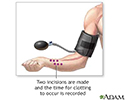Bleeding time
Bleeding time is a medical test that measures how fast small blood vessels in the skin stop bleeding.
How the Test is Performed
A blood pressure cuff is inflated around your upper arm. While the cuff is on your arm, the health care provider makes two small cuts on the lower arm. They are just deep enough to cause a tiny amount of bleeding.
The blood pressure cuff is immediately deflated. Blotting paper is touched to the cuts every 30 seconds until the bleeding stops. The provider records the time it takes for the cuts to stop bleeding.
How to Prepare for the Test
Certain medicines can change blood test results.
- Tell your health care provider about all the medicines you take.
- Your provider will tell you if you need to temporarily stop taking any medicines before you have this test. This may include dextran and aspirin or other nonsteroidal anti-inflammatory drugs (NSAIDs).
- Do not stop or change your medicines without talking to your doctor first.
How the Test will Feel
The tiny cuts are very shallow. Most people say it feels like a skin scratch.
Why the Test is Performed
This test helps diagnose bleeding problems.
Normal Results
Bleeding normally stops within 1 to 9 minutes. However, values may vary from lab to lab.
What Abnormal Results Mean
Longer-than-normal bleeding time may be due to:
- Blood vessel defect
-
Platelet aggregation defect
Platelet aggregation defect
The platelet aggregation blood test checks how well platelets, a part of blood, clump together and cause blood to clot.
Read Article Now Book Mark Article -
Thrombocytopenia
(low platelet count)
Thrombocytopenia
Thrombocytopenia is any disorder in which there is an abnormally low amount of platelets. Platelets are parts of the blood that help blood to clot. ...
Read Article Now Book Mark Article
Risks
There is a very slight risk of infection where the skin is cut.
References
Schafer A. Approach to the patient with bleeding and thrombosis In: Goldman L, Schafer AI, eds. Goldman's Cecil Medicine . 24th ed. Philadelphia, PA: Elsevier Saunders; 2011:chap 174.
Schmaier AH. Laboratory evaluation of hemostatic and thrombotic disorders. In: Hoffman R, Benz EJ Jr, Silberstein LE, Heslop HE, Weitz JI, Anastasi J, eds. Hematology: Basic Principles and Practice . 6th ed. Philadelphia, PA: Elsevier Saunders; 2011:chap 131.
-
Blood clot test - illustration
The bleeding time test is used to evaluate how well a person's blood is clotting. The test evaluates how long it takes the vessels cut to constrict and how long it takes for platelets in the blood to seal off the hole. Blood vessel defects, platelet function defects, along with many other conditions can result in prolonged bleeding time.
Blood clot test
illustration
-
Blood clot test - illustration
The bleeding time test is used to evaluate how well a person's blood is clotting. The test evaluates how long it takes the vessels cut to constrict and how long it takes for platelets in the blood to seal off the hole. Blood vessel defects, platelet function defects, along with many other conditions can result in prolonged bleeding time.
Blood clot test
illustration
Review Date: 1/27/2015
Reviewed By: Yi-Bin Chen, MD, Leukemia/Bone Marrow Transplant Program, Massachusetts General Hospital, Boston, MA. Also reviewed by David Zieve, MD, MHA, Isla Ogilvie, PhD, and the A.D.A.M. Editorial team.

